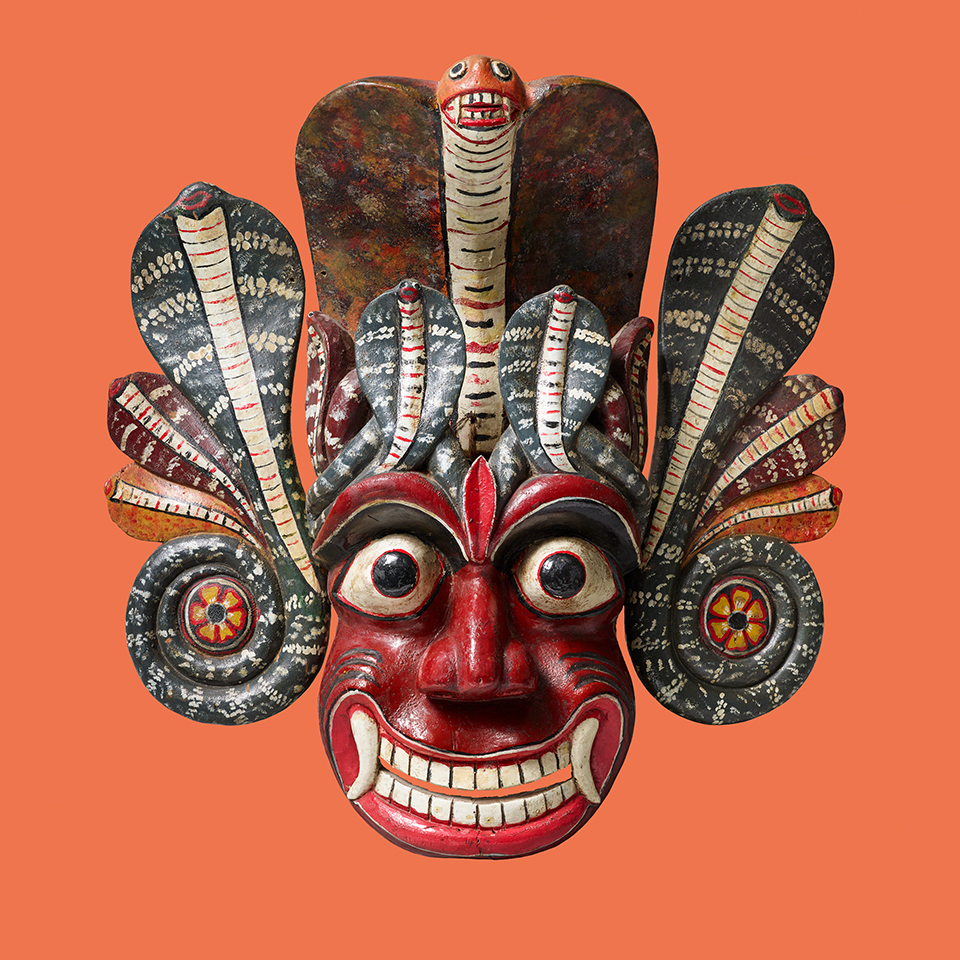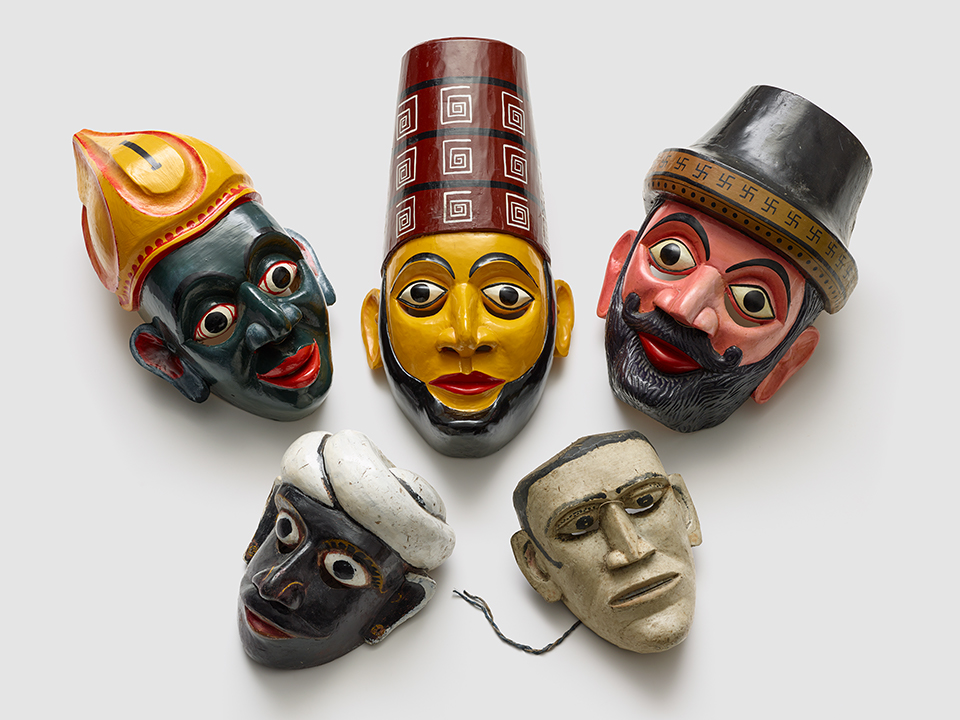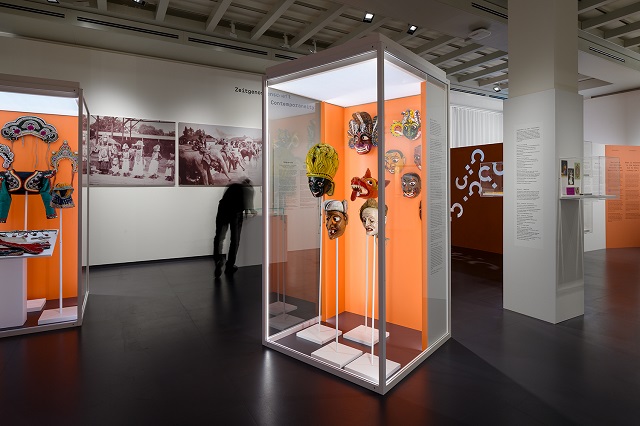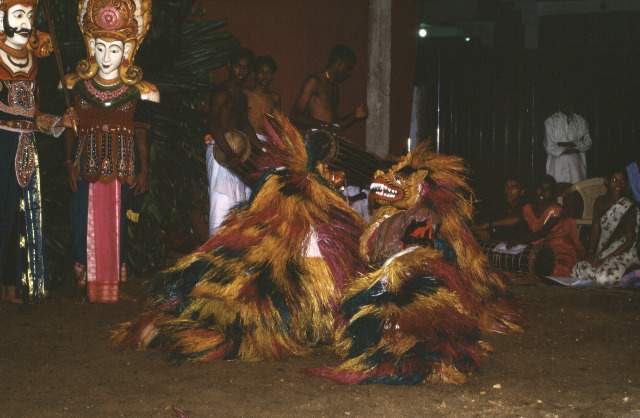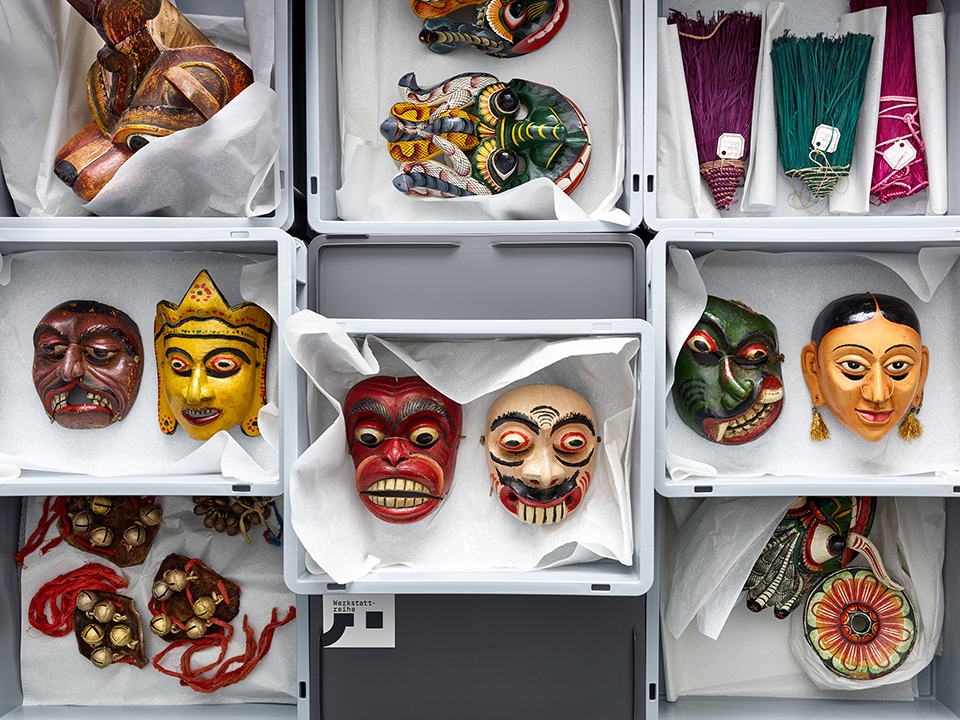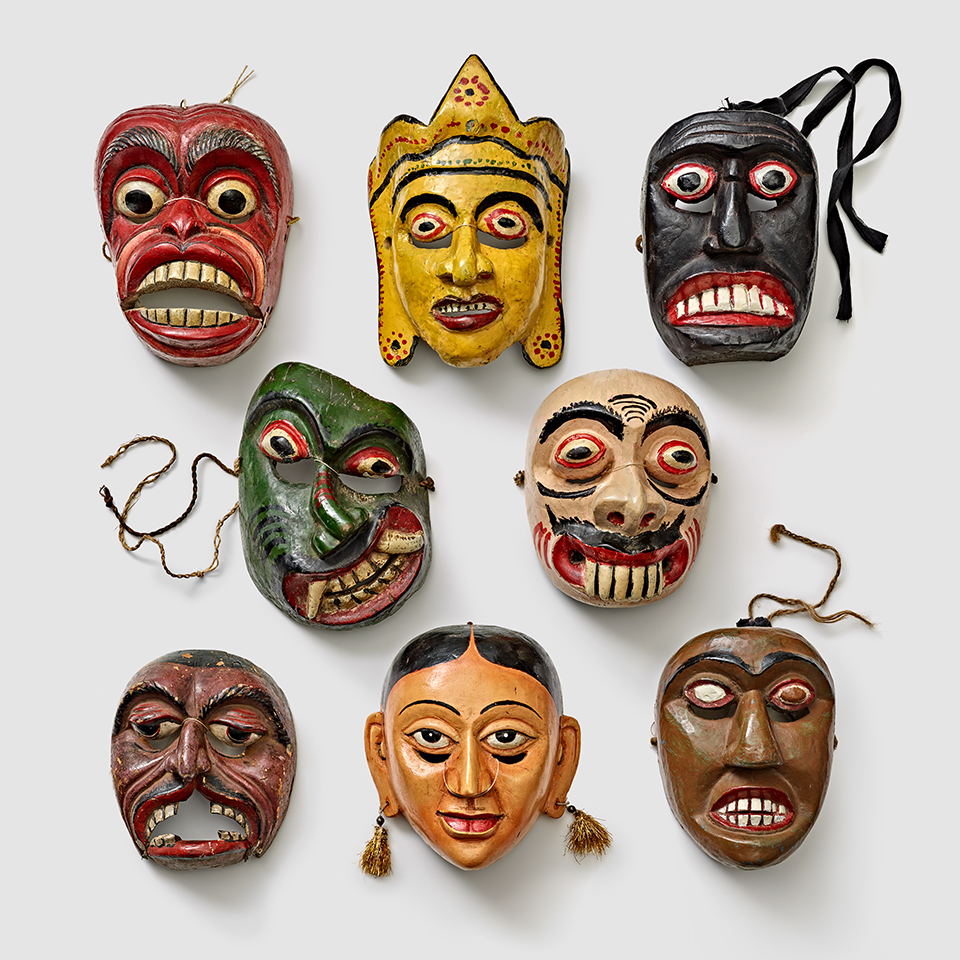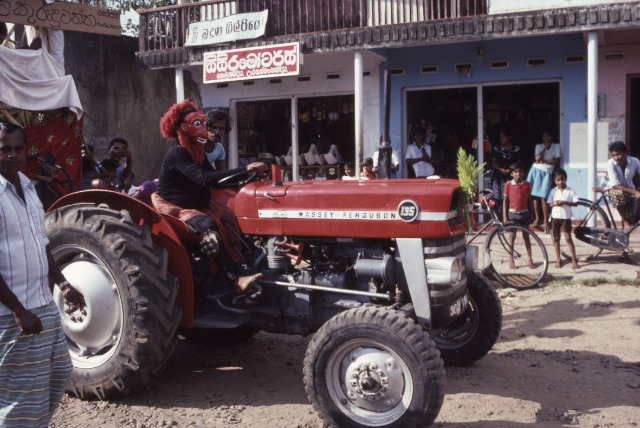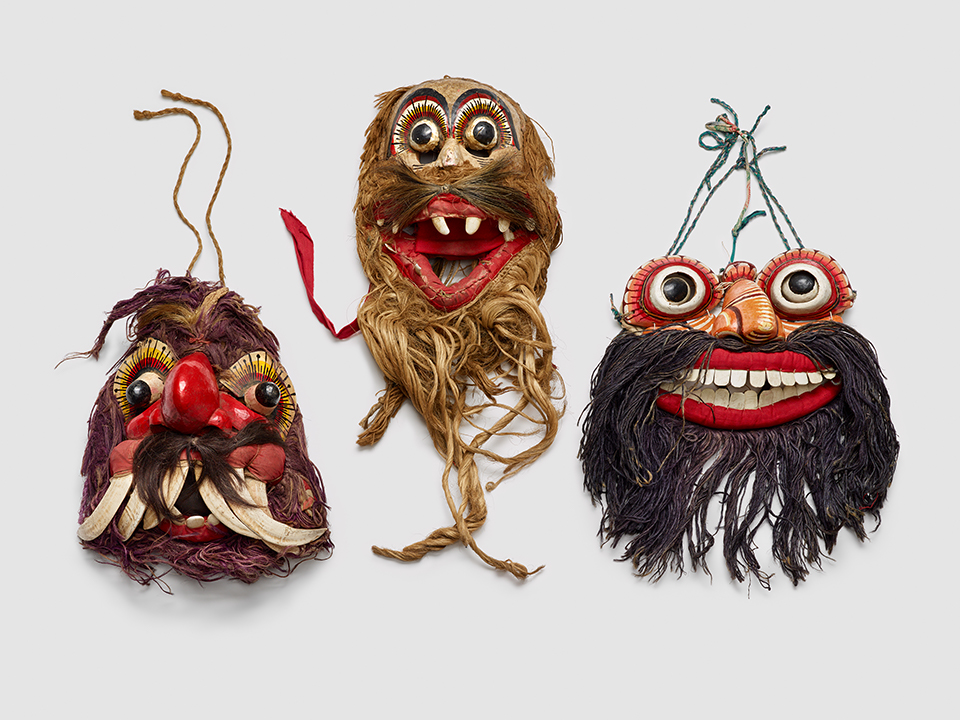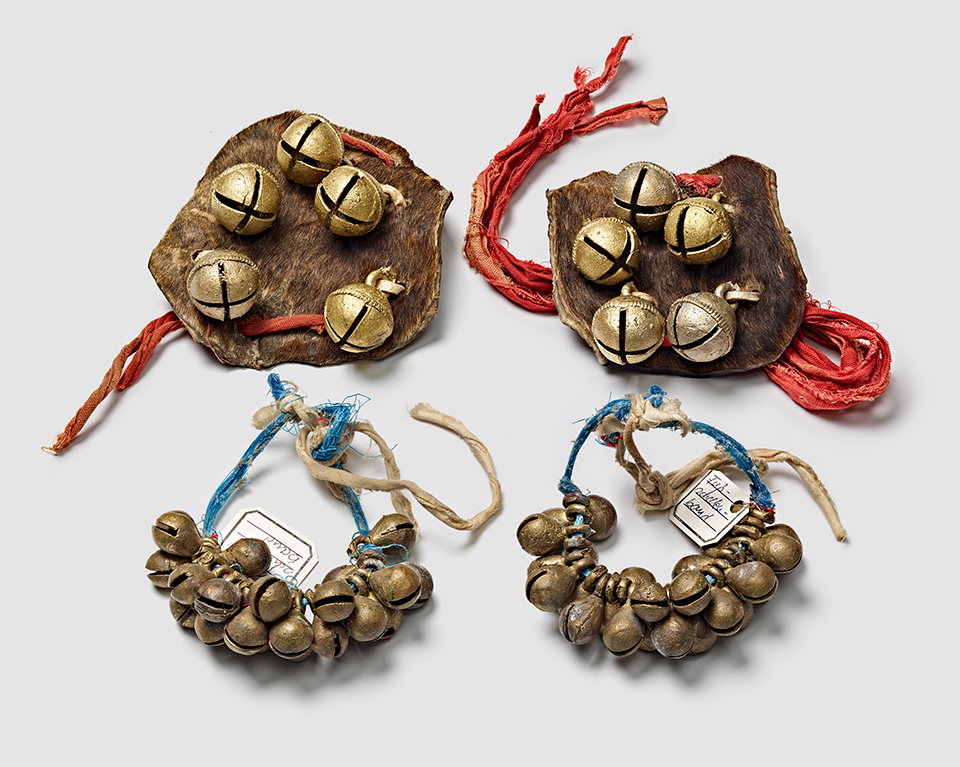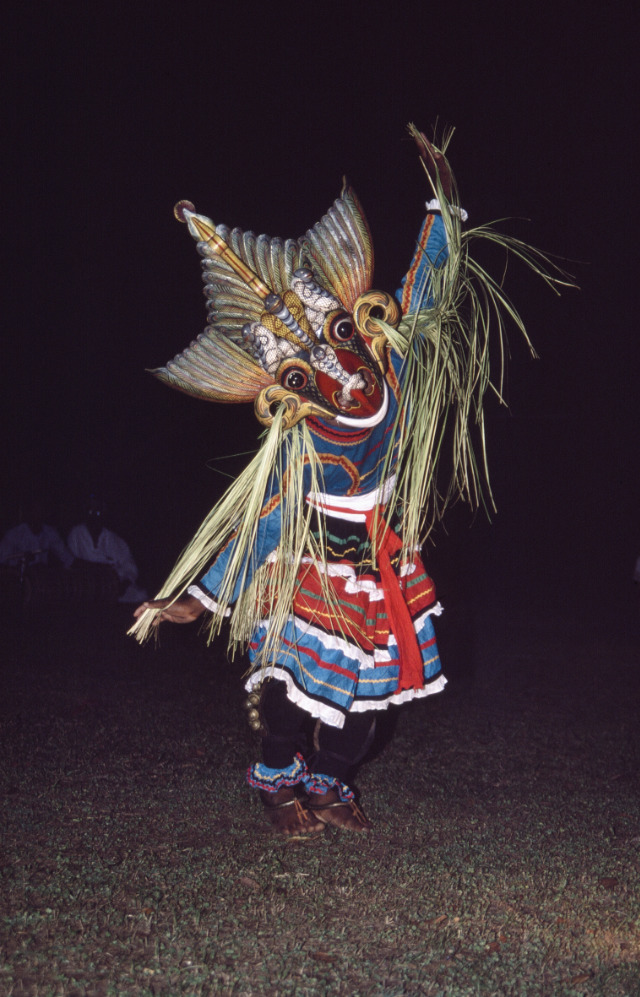Media Release and Material
Zurich, 7 July 2023
Who Sees What? Ritual Costumes from Sri Lanka, a Reflection on Encounters
The workspace exhibition “Mask Dances?” at the Ethnographic Museum at the University of Zurich showcases newly acquired masks, costumes and ritual objects from Sri Lanka. Until 1947, such objects, originally used in healing rituals and ritual dances, were also part of the Zurich “Völkerschauen” ethnic shows, at which “natives from Ceylon” performed “devil dances”. The exhibition is intended to create space for dialogue and exchange and to critically reflect on the museum’s own history.
The German ethnologists Wolfgang Mey and Anna Wischkowski-Mey collected over 700 objects, including masks, other costume pieces and ritual objects from Sri Lanka, over two decades from 1984 to 2006. The collection was recently acquired by the Ethnographic Museum – just how recently is evident from the many transport and storage boxes still containing objects piled up at the back of the exhibition room. Sometimes visitors to the exhibition will also see the restorers, the registrar and the curator going about their work: unpacking, examining, recording, conserving, repacking or placing items in the exhibition.
Mask Dances? 5 Questions on Ritual Costumes from Sri Lanka is the fourth exhibition in the workspace series at the UZH Ethnographic Museum – a series designed to raise questions and make museum research processes visible. That means the exhibition will keep evolving right through to September 2024. The basic underlying credo, however, remains the same: encounters with apparent “others” are actually meetings of contemporaries to which all parties bring specific knowledge and skills. Such encounters are opportunities to hear diverse voices and to exchange experiences – provided those involved are willing and able to really attend to and listen to each other carefully. The exhibition is an invitation to do so. Conceptually, it is arranged around three different epochs:
1984 to 2006: the collecting of objects in Sri Lanka
At the center is the intensive ethnological research conducted by Wolfgang Mey and Anna Wischkowski-Mey on healing rituals and Kolam dances in the Ambalangoda region of south-west Sri Lanka. From 1984 to 2006, the two ethnologists, together with Sinhalese ritual specialists such as Bandu Wijesooriya and Karolis Gurunnanse (Master Karolis), researched and documented ritual practices, that is performative actions that combine spiritual, political and social concerns and also provide entertainment. Over the years, long-term relationships characterized by trust and mutual appreciation were formed between the ethnologists and the local specialists. The collection consists of a great number of objects given to or bought by the researchers, which the Ethnographic Museum at the University of Zurich was able to purchase in 2022 thanks to the UZH Investment Fund.
1885 to 1947: Zurich “Völkerschauen” with people from “Ceylon”
Almost 100 years earlier, the enterprising businessman Carl Hagenbeck, who specialized in “ethnic shows”, brought his “anthropological-zoological Sinhalese exposition” to Switzerland for the first time. In 1885, visitors could watch displays featuring 51 people from “Ceylon”, as Sri Lanka was then known, as well as 12 elephants and eight zebu cattle. The focus of such shows lay not in giving an authentic portrayal of a real culture, but rather in staging a lucrative spectacle. Much remains unknown about the shows – such as whether the Sri Lankans had come to Europe voluntarily, if they had a say in what they performed, and what they thought about the Zurich audiences. Neither do we know whether the Swiss public regarded these “strangers” as real individuals, as their contemporaries.
People from Sri Lanka were on show in Zurich on at least six separate occasions that we know of – the last time in Circus Knie on Sechseläutenplatz in 1947. These “ethnic shows” are a murky chapter in the history of the city of Zurich and an aspect of Switzerland’s past which the country has only recently begun to deal with. The “Mask Dances?” exhibition aims to create a space in which the topic can be brought out of the shadows and finally examined and discussed.
From 2023: the collection as impulse for encounters and reflections
The Ethnographic Museum is using the newly acquired Mey Wischkowski collection as an opportunity to reflect on the past, to shape the present, and to intuit the future, all from a perspective of contemporaneous equals. “At the time these “ethnic shows” took place, many ethnographic museums in Europe were acquiring masks and ritual objects from Sri Lanka. But the record cards were fairly devoid of information,” says curator Martina Wernsdörfer, Asia specialist at the Ethnographic Museum. “Thanks to the Mey Wischkowski collection, such objects can now be seen in a new light and interpreted differently.” One aspect that was not picked up on for many years is the criticism by the indigenous people of their colonial masters depicted in the Kolam dances: the Sri Lankan people observed the affected manners of the European colonialists and mimicked them in their performances. The masks that represented the colonial rulers were seen (by the westerners) as “exotic” and eagerly collected.
“The “Mask Dance?” exhibition sets the stage for communal observing, researching, reflecting, questioning and knowledge sharing,” says Wernsdörfer. How and in what direction the exhibition evolves between now and September next year will depend on who comes into conversation with whom. “You are all invited to take part and contribute to the reflections that emerge from this workshop exhibition format.”
|
Mask Dances? 5 Questions on Ritual Costumes from Sri Lanka Exhibition opening event: 13 July 2023 at 6:00pm Download press release (PDF, 123 KB)11.07.2023 «Mask Dances?» |
|
Workspace series |
Contacts
Ethnographic Museum at the University of Zurich
Dr. Martina Wernsdörfer, curator
+41 44 634 90 21
wernsdoerfer@vmz.uzh.ch
Media Relations
University of Zurich
+41 44 634 44 67
mediarelations@kommunikation.uzh.ch
|
Legal notice Copyright All content, text, images, graphics, photographs or other files on our website are protected by copyright. They belong exclusively to the University of Zurich or to the expressly named copyright holders. The use of any elements - in particular commercial use - by third parties is prohibited unless the express written consent of the copyright holder has been obtained or obtained in advance from third parties. The mere downloading or copying of content, text, images, graphics, photographs or other files does not transfer any rights. Permission of use for media representatives The image files, graphics or photographs expressly designated as "press pictures" on our website may be used exclusively by media representatives (free of charge), provided that the media coverage is in connection with a past, current or future exhibition. The aforementioned use must necessarily include the following photo credit: © Völkerkundemuseum der Universität Zürich, photographer: respective surname, first name. Any other use is prohibited. |
